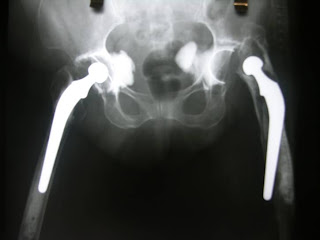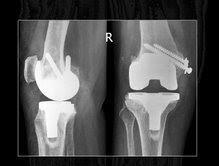
Femoral stem is jammed thru the cortical window, porotic bone and and ofcourse the mushroom shaped acetabular cement mantle.
plan
ETO, 2 stage revision, mobile spacer Plate back up in case of fracture as the bone is porotic. Vascular back up and Ilioinguinal exposure plan ready in case of iliac vessel bleed. Angio with limb movement to see if any kinking occurs. As planned we had all the problems execpt vascular injury. We used a plate to tie the ETO stabilising wires as the cortex was too thin to hold the wires. Iv antiobiotic was given for 6 weeks followed by oral rifampicin. Subcutaneous forteo was given to improve bone quality. she did not return for the second stage revision. My worries include further acetabular bone loss with abrasive wear, breakage of the spacer and rarely dislocation. May be a static spacer could avoid these problems. Sorry, I just heard she had a stage 2 revision elsewhere and is walking.



